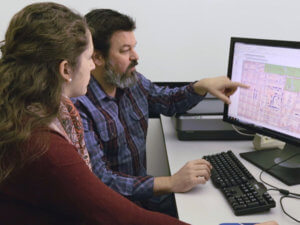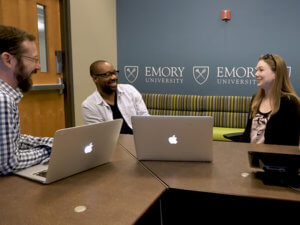Emory Center for Digital Scholarship (ECDS)
Established in 2013
http://digitalscholarship.emory.edu/
Staff: 13 FTE, including 3 librarians and 2 faculty members
The center also employs 30+ graduate students and 2 undergraduate students.
Campus Partners: More than a dozen campus partners, including the Michael C. Carlos Museum, the Fox Center for Humanistic Inquiry, and the Pitts Theology Library
http://digitalscholarship.emory.edu/about/affiliations/index.html
Overview

The Emory Center for Digital Scholarship (ECDS), housed on the third floor of the Robert W. Woodruff Library, was established in 2013 to provide consultation and support for research, open access publication, online exhibitions, data curation, and digital pedagogy to the Emory University and greater Atlanta community. ARL touched base with ECDS co-director Wayne H. Morse Jr., who provided us with an inside look into the center’s organization and activities, as well as a glimpse at ECDS’s future.
ECDS emerged from the recommendations of a Digital Scholarship Task Force, formed by enterprise CIO and senior vice provost for library services and digital scholarship, Rich Mendola, to whom the center’s co-directors now report. The vision of the ECDS was to model a unified support infrastructure for digital scholarship (DS) happening within the Emory community. To achieve this vision of a one-stop center for all things DS, ECDS brought together several existing library and IT groups active in the digital sphere to form a combined physical and virtual center for digital scholarship based in the library.
Several former entities were combined during the 2013 formation of ECDS:
- Lewis H. Beck Center for Electronic Collections (est. 1994)
- Digital Scholarship Commons (DiSC) (est. 2011)
- Emory Center for Interactive Teaching (ECIT) (est. 1998)
- Electronic Data Center (est. 1996)
- Southern Spaces, a peer-reviewed, open access journal (est. 2004)
One of the larger such outfits at an ARL library, ECDS remains agile by leveraging the strengths and resources it enjoys as part of a merged library and IT organization, as well as by fostering partnerships—something already practiced in one of its earlier iterations. A combination of both “hard” and “soft” funding also allows for agility in hiring and equipping ECDS projects. As a result, innovation and experimentation are strongly encouraged, with project proposals welcomed on a rolling basis.
Staffing and Services

Emory University
ECDS brings together a diverse array of specialists who collaborate on developing innovations in digital scholarship, including expertise in the following areas:
- Network, statistical, and text analysis
- Digital pedagogy
- Digital publishing
- GIS and mapping
- Multimedia production
- Online exhibitions
- Virtual and augmented reality
Staff roles at the ECDS run from digital scholarship strategist, digital text specialist, educational analyst, geographer, and GIS specialist, to head of data services, outreach coordinator, special project liaison, systems lead, training coordinator, UI/UX software engineer, video producer, and visual information specialist. In short, the center houses a robust complement of expertise under one roof upon which Emory faculty, students, staff, and local community members can draw as they pursue their digital scholarship goals. ECDS staff serve as: consultants and digital scholarship support for research projects, data visualizations, digital publications, and online exhibitions; digital pedagogy experts, assisting faculty with integrating DS tools and methods into their courses and assignments; and instructors, offering certificates in, for example, Digital Scholarship and Media Studies. To help manage the diverse workload and encourage ongoing learning, the ECDS makes its project proposal guidelines and process transparent online, posts resources for developers on GitHub and highlights several open source initiatives on its website, and maintains the “self-service” Project Management for the Digital Humanities (PM4DH) website.
Naturally, being situated within the Woodruff Library, Emory University librarians are integral partners to the ECDS. Librarians serve as proposal reviewers, on project teams and as project coordinators, and as key proponents of the ECDS’s offerings. Workshops, online programs, and information briefs tailored for librarians are part of the center’s overall outreach plan, and dialogue between ECDS staff and subject librarians allows for fruitful cross-pollination regarding DS trends on campus.
Recognizing that facility with the tools and methods of digital scholarship is critical for participation in the current scholarly landscape, the ECDS offers a unique internship program for graduate students that provides real-world experience while at the same time training a cadre of experts to work on center projects. Currently, the ECDS’s 35 graduate students come from multiple departments within the university, and also perform outreach in their fields for both the center itself and for digital scholarship more broadly. The undergraduates based in the ECDS can take advantage of the center’s expertise in data analysis as they work on honors projects. Undergraduate students also perform research using digital scholarship tools and methods provided by the ECDS as a part of their coursework.
In addition to the digital scholarship activities highlighted above, it is notable that situated within the ECDS is Emory’s born-digital university press, whose publications include four multimedia, open access, academic journals and a web magazine, all of which model public scholarship and result in expertise in digital publishing being situated right within the library at the ECDS.
Projects

Emory University
While the work of the ECDS began in collaboration with faculty in the field of art history (a common origin story for digital scholarship centers), it soon expanded to include additional fields from the humanities, social sciences, and environmental science. We would be remiss in not mentioning one of Emory’s best-known, longest-lived, and most-extensive digital projects, Voyages: The Trans-Atlantic Slave Trade Database, a project with origins in the 1960s and continually updated today.
Today the ECDS is working ever more closely with the health sciences, through projects such as the Sickle Cell Information Center (a revamp of a resource begun in 1997) and a collaboration with the National Ebola Training and Education Center (NETEC). Another area of growth has been interdisciplinary projects on the history and culture of Atlanta, which frequently incorporate geospatial and 3-D data, such as the Atlanta Explorer, the Battle of Atlanta Tour App, and the Georgia Coast Atlas. ECDS also hosts the annual Atlanta Studies Symposium in partnership with numerous local institutions. The symposium is a venue and an opportunity for scholars to showcase new research on the city and its environs; this year, the theme is “Atlanta in the Anthropocene: The Making of a Resilient, Resourceful City.”
Featured ProjectsSouthern Spaceshttp://digitalscholarship.emory.edu/projects/publications/southern-spaces.html  Southern Spaces is a peer-reviewed, multimedia, open access journal that publishes articles, photo essays, reviews, interviews, presentations, and short videos about real and imagined spaces and places of the US South as well as their global connections. Southern Spaces publishes work that analyzes many “souths” and southern regions, offers critical scrutiny of a monolithic “South,” interrogates historical developments and geographies over time, and maps expressive cultural forms associated with place and space. Slave Voyages slave vessel Martha (right), June 6, 1850 The Trans-Atlantic Slave Trade Database has information on almost 36,000 slaving voyages that forcibly embarked over 10 million Africans for transport to the Americas between the 16th and 19th centuries. The actual number is estimated to have been as high as 12.5 million. The database and the separate estimates interface offer researchers, students, and the general public a chance to rediscover the reality of one of the largest forced movements of peoples in world history. Readuxhttp://digitalscholarship.emory.edu/projects/software/readux.html  Readux is an open source platform that enables users to explore and engage with the visually rich and diverse materials digitized in Emory library collections, including 19th-century African American literature and travel guides, early Northern European emblem books, and more than 1,200 yellowback novels. The platform provides multiple layers of access to these collections including browsing, annotation, and export of digital editions. |
Successes, Challenges, and Opportunities

Steve Bransford/Emory University
We asked Wayne Morse to reflect on the ECDS’s biggest achievements since its launch in 2013, and he highlighted the following:
- “Successfully bringing digital scholarship at Emory from the edges to a central focus of the university through the center’s projects, teaching, outreach, and resources.”
- “Engaging the Atlanta metro region in digital public scholarship via the Atlanta Studies Network and other initiatives.”
- “Successfully blending library and IT cultures into one team. Receiving superior scores on an employee satisfaction survey, the highest overall within the LITS division.”
- “Creating the Digital Scholarship Internship Program (DSIP) for graduate students to learn digital scholarship skills, theories, and methods relating to research and pedagogy. This program empowers the graduate students with marketable skills for both the academic and alt-ac opportunities while generating a pool of qualified teammates for projects and outreach initiatives.”
As with all digital scholarship centers at ARL libraries, the ECDS must continually adapt to meet its community’s needs in research, teaching, and learning. Among the challenges that Morse shared with us are the following:
- “Institutionalizing digital scholarship at Emory without becoming an institution. Remaining agile and a center for innovation while working to create sustainable, scalable scholarly projects.”
- “Creating new relationships with presses and other organizations to get digital work published. Crafting partnership agreements…that leverage ECDS’s digital resources in support of scholarly publishing.”
- “Supporting a dialogue on Emory’s campus in support of recognizing faculty’s digital work as part of their professional development. Building on efforts by select departments and organizations across campus to create a more uniform understanding throughout the university.” To this end, ECDS maintains a webpage with several professional organizations’ guidelines for the evaluation of digital scholarship in research and teaching.
And lastly, we asked Morse to look five to ten years into the future. Finding inspiration in Dan Cohen’s closing plenary at the 2017 ARL-CNI Digital Scholarship Planning workshop, he shared with us these sage parting words: “Strengthening…partnerships, updating project processes and workflows, and continuing to practice empowerment are keys to minimizing barriers and making digital scholarship tools more accessible to all.”
Elizabeth Waraksa | 202-296-2296 | elizabeth@arl.org | July 3, 2019


